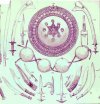- Joined
- May 24, 2001
- Messages
- 443
According to Rawson "The Indian Sword" page 103,
"Despite the fact that in modern times the Kukri has come to be regarded as the national weapon of the Gurkhas, its form shows that it is a weapon of purely Indian descent, related to the kopis-bladed sword of Ajanta, and the modern Rajput Sosun Pattah. The Kora is the true traditional Gurkha weapon"
What do you think of thie theory? If he is right, then why and when did the Gurkhas discarded Kora in favor of Khukuris?
Regards,
Manoucher
"Despite the fact that in modern times the Kukri has come to be regarded as the national weapon of the Gurkhas, its form shows that it is a weapon of purely Indian descent, related to the kopis-bladed sword of Ajanta, and the modern Rajput Sosun Pattah. The Kora is the true traditional Gurkha weapon"
What do you think of thie theory? If he is right, then why and when did the Gurkhas discarded Kora in favor of Khukuris?
Regards,
Manoucher

